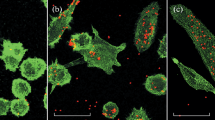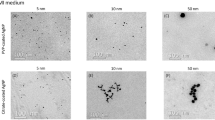Abstract
Purpose. The nature of interactions between macrophages and drug carriers is of primordial importance either in the design of more effective therapeutic strategies for macrophage-associated pathogenesis or in establishing new approaches for pharmacological action avoiding macrophages.
Methods. Polyalkylcyanoacrylate nanoparticles (PMCA, PECA, PBCA and PIBCA nanoparticles) were assayed for their toxicity on peritoneal resident and thioglycolate-elicited macrophages. Cellular viability was assessed by MTT tetrazolium salt assay, oxidative burst by NBT reduction and NO production by nitrite evaluation.
Results. The nanoparticles tested led to cellular morphological modifications and induced toxicity in both types of macrophages in culture. The polyalkylcyanoacrylate nanoparticles uptake by peritoneal macrophages caused an increase in respiratory burst, as assessed by the NBT reduction assay, and induced the release of soluble toxic factors to the culture medium. The association of LPS with the PMCA nanoparticles significantly stimulated the production of nitric oxide (NO) by resident macrophages. In contrast, the association of PBCA nanoparticles with LPS does not increase the nitrite production as compared with LPS alone, which may be due to a different physico-chemical interaction between LPS and the two types of polymers.
Conclusions. In cultured mice peritoneal macrophages, nanoparticles of PACA induce the production of oxygen reactive products, which cause changes in the cell metabolism of both resident and elicited macrophages. PMCA nanoparticles in association with LPS significantly increase the expression of the inducible isoform of nitric oxide synthase, leading to the release of large amount of NO, which may be highly cytotoxic to the cultured cells in the presence of peroxide generated from the oxidative burst.
Similar content being viewed by others
REFERENCES
J. Kreuter. Eur. J. Drug Metab. and Pharmacokinetics 3:253–256 (1994).
E. M. Gipps, P. Groscurth, J. Kreuter, and P. P. Speiser. J. Pharm. Sci. 77:208–209 (1988).
K. Decker. Eur. J. Biochem. 192:245–261 (1990).
U. K. Meßmer, E. G. Lapetina, and B. Brüne. Molecular Pharmacol. 47:757–765 (1995).
A. E. Stuart, J. A. Habeshaw, and A. E. Davidson. In D. M. Weir, Cellular Immunology, Blackwell Scientific Publications, Oxford-London-Edinburgh-Melbourne, 1973, pp 24.1–24.26.
R. Gaspar, V. Préat, F. R. Opperdoes, and M. Roland. Pharm. Res. 9:782–787 (1992).
C. Verdun, P. Couvreur, H. Vranckx, V. Lenaerts, and M. Roland. J. Control. Rel. 3:205–210 (1986).
M. C. Lopes, L. Guilhermino, A. Donato, L. Silveira, A. M. V. M. Soares, and A. P. Carvalho. Toxic. in vitro 8:831–834 (1994).
E. Pick. Methods Enzymol. 132:407–421 (1986).
J. E. Ogden and P. K. Moore. Trends in Biotechnol. 13:70–78 (1995).
C. Lourenço, M. Teixeira, S. Simões, and R. Gaspar. Int. J. Pharm. 138:1–12 (1996).
E. M. Gipps, P. Groscurdl, J. Kreuter, and P. Speiser. Int. J. Pharm. 40:23–31 (1987).
C. Lherm, R. H. Müller, F. Puisieux, and P. Couvreur. Int. J. Pharm. 84:13–22 (1992).
H. Pinto-Alphandary, O. Balland, M. Laurent, A. Andremont, F. Puisieux, and P. Couvreur. Pharm. Res. 11:38–46 (1994).
C. E. Alford, T. E. King, and P. A. Campbell. J. Exp. Med. 174:459–466 (1991).
F. Nemati, C. Dubernet, A. Colin de Verdière, M. F. Pouppon, L. Treupel-Acar, F. Puisieux, and P. Couvreur. Int. J. Pharm. 102:55–62 (1994).
L. Vansnick, P. Couvreur, D. Leyh, and M. Roland. Pharm. Res. 1:203–208 (1985).
V. Lenaerts, P. Couvreur, D. Christiaens-Leyh, E. Joiris, M. Roland, B. Rollman, and P. Speiser. Biomaterials 5:65–68 (1984).
M. Stein and E. Hamacher. Int. J. Pharm. 80:R11–R13 (1992).
R. Fernández-Urrusuno, E. Fattal, D. Porquet, J. Féger, and P. Couvreur. Pharm. Res. 12:1385–1387 (1995).
Author information
Authors and Affiliations
Corresponding author
Rights and permissions
About this article
Cite this article
Cruz, T., Gaspar, R., Donato, A. et al. Interaction Between Polyalkylcyanoacrylate Nanoparticles and Peritoneal Macrophages: MTT Metabolism, NET Reduction, and NO Production. Pharm Res 14, 73–79 (1997). https://doi.org/10.1023/A:1012059501947
Issue Date:
DOI: https://doi.org/10.1023/A:1012059501947




